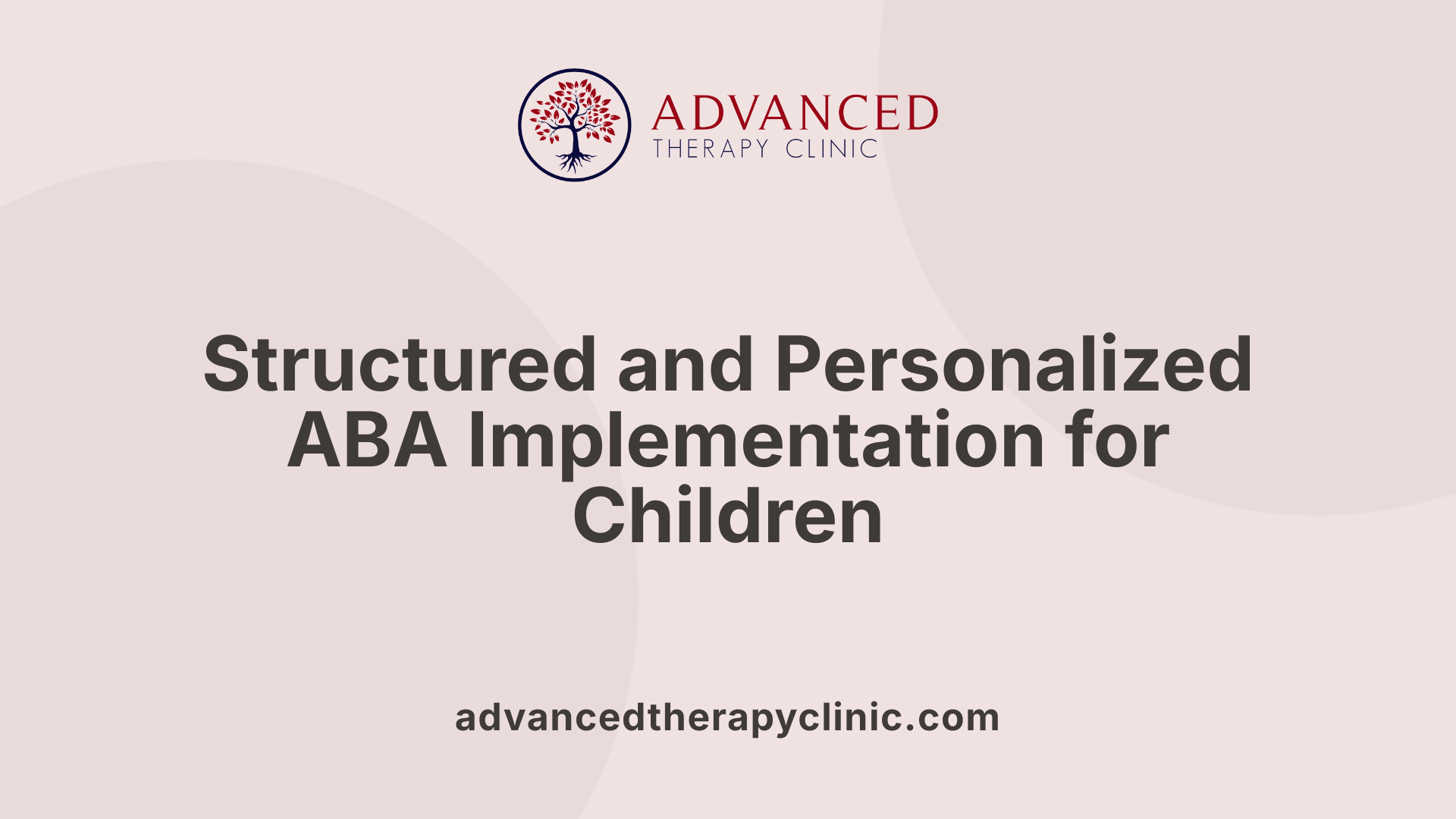Examples of Aba Therapy for Autism


Understanding ABA Therapy and Its Role in Autism Treatment
Applied Behavior Analysis (ABA) is a scientifically supported approach widely used in the treatment of autism spectrum disorder (ASD). Its techniques focus on improving communication, social skills, and reducing problematic behaviors. This article explores various ABA methods, their application in real-world settings, research backing their efficacy, and the beneficial outcomes observed in children and adults with autism.
Core Principles and Methods of ABA Therapy

What are the principles and methods underlying ABA therapy for autism?
Applied Behavior Analysis (ABA) is rooted in the scientific understanding of learning and behavior. Its foundation rests on operant conditioning, a process where behaviors are influenced by their consequences — either reinforced or punished to increase or decrease certain actions.
At the heart of ABA therapy is a detailed approach to analyzing behaviors through the ABC model, which stands for Antecedent, Behavior, and Consequence. This model helps therapists identify triggers and reactions, enabling targeted interventions to modify behaviors effectively.
ABA relies heavily on reinforcement strategies. Positive reinforcement involves rewarding desirable behaviors—like giving praise or tokens—to encourage these actions to happen more frequently. For example, a child might earn a sticker for completing a task, which motivates them to repeat the behavior.
In addition to reinforcement, ABA employs several techniques to teach new skills and modify existing habits:
- Behavior Chaining: This technique breaks down complex tasks into smaller steps, gradually teaching the entire sequence.
- Prompt Fading: Therapists initially provide cues or assistance to help initiate behavior, then gradually reduce support.
- Environmental Adjustments: Modifying surroundings to prevent problematic behaviors or promote positive ones.
The goal of ABA is to encourage meaningful behavior change across various settings, ensuring skills learned are generalized and maintained over time. Its scientific rigor adheres to established dimensions, such as being data-driven, systematic, and conceptually consistent, which supports its validation as an effective therapy.
Research consistently shows that intensive ABA—typically involving 25-40 hours per week over one to three years—can significantly improve communication, social skills, and daily functioning for children with autism.
In summary, ABA combines systematic analysis with evidence-based methods to foster adaptive behaviors while reducing harmful ones, grounded in the principles of scientific learning and behavior modification.
Key Techniques in ABA for Autism Treatment

What are the main techniques used in Applied Behavior Analysis (ABA) therapy for autism?
Applied Behavior Analysis (ABA) therapy utilizes a range of proven methods grounded in the science of learning and behavior. The core strategies focus on increasing helpful behaviors and reducing problematic ones through individualized interventions.
A prominent technique is positive reinforcement. This approach involves rewarding behaviors to encourage their repetition, such as offering praise, tokens, or other rewards when a child completes a task or demonstrates a desired behavior.
One widely used structured method is Discrete Trial Training (DTT). DTT involves one-on-one sessions where therapists present clear prompts, wait for a response, and then provide positive reinforcement. This step-by-step process helps children acquire specific skills, ranging from communication to daily living tasks.
Visual tools like modeling are also essential. Therapists demonstrate behaviors through live shows, video recordings, or audio examples, encouraging children to imitate and learn social or communication skills.
For children with speech challenges, the Picture Exchange Communication System (PECS) is highly effective. PECS uses pictures or symbols that children can exchange for items or actions, facilitating non-verbal or minimally verbal communication.
Reinforcement systems often involve prompting, where behaviors are encouraged with cues, and reinforcement is withheld if behaviors aren’t performed. When the desired behavior occurs, children are rewarded with tokens, praise, or other positive feedback.
In addition, ABA employs task analysis, breaking complex skills into smaller, manageable steps, and chaining, which reinforces a sequence of steps to accomplish goal behaviors such as dressing or cooking. Prompting strategies help guide children through steps, gradually fading so they can perform tasks independently.
Other techniques like extinction, redirection, and social stories further support behavior modification by addressing specific behavioral challenges and building social understanding.
Overall, ABA therapy is tailored to each child, using continuous assessment and data collection to adapt interventions. Techniques combine to develop communication, social, self-care, and academic skills, ultimately fostering greater independence and quality of life for children with autism.
Implementation of ABA Therapy for Children with Autism
 ABA therapy is delivered through carefully structured and personalized sessions designed to meet each child's unique needs. These sessions are often overseen by a Board Certified Behavior Analyst (BCBA) or trained therapists with expertise in ABA techniques. During therapy, therapists use a variety of evidence-based strategies such as positive reinforcement, prompting, modeling, and naturalistic teaching to help children acquire new skills and reduce behaviors that may interfere with learning or social interactions.
ABA therapy is delivered through carefully structured and personalized sessions designed to meet each child's unique needs. These sessions are often overseen by a Board Certified Behavior Analyst (BCBA) or trained therapists with expertise in ABA techniques. During therapy, therapists use a variety of evidence-based strategies such as positive reinforcement, prompting, modeling, and naturalistic teaching to help children acquire new skills and reduce behaviors that may interfere with learning or social interactions.
A central aspect of ABA implementation involves analyzing the antecedents, behaviors, and consequences (A-B-Cs). This approach helps therapists understand what triggers certain behaviors, how the child responds, and what outcomes influence future actions. By examining these factors, therapists can develop targeted interventions that effectively change behavior patterns.
To facilitate learning, goals are broken into small, manageable steps. Each step is reinforced with rewards, like praise, tokens, or preferred activities, to encourage skill mastery. These incremental goals make complex behaviors, such as communicating needs or performing daily tasks, more accessible and achievable for the child.
Importantly, ABA strategies are not confined to clinical settings. They are seamlessly integrated into daily routines and natural environments like home, school, or community settings. This integration helps promote generalization, where children can apply learned skills across different contexts, fostering independence and improving overall quality of life.
In summary, ABA therapy for children with autism involves tailored, goals-focused interventions that analyze behavior patterns, utilize proven techniques, and are embedded in everyday life to support meaningful progress and skill development.
Practical Applications and Case Examples of ABA in Autism Support

How is ABA therapy applied for individuals with autism?
Applied Behavior Analysis (ABA) offers versatile solutions for various challenges faced by individuals with autism. Its practical uses span across improving communication, reducing problematic behaviors, and developing essential life skills.
One of the main applications is in enhancing communication abilities. ABA techniques like Discrete Trial Training (DTT) and Picture Exchange Communication System (PECS) help children learn to request items, comment on their environment, or respond appropriately during interactions. For example, a child may be taught to use pictures to ask for a toy or express feelings, significantly reducing frustration.
Another significant area is behavior management. ABA employs strategies such as positive reinforcement—rewarding desired behaviors with praise or tokens—to encourage repetitions of good behaviors. It effectively diminishes problematic actions like tantrums, aggression, or self-injury through methods such as differential reinforcement and extinction.
Furthermore, ABA is highly beneficial in fostering daily living skills. Structured programs train individuals in self-care routines—including dressing, personal hygiene, and simple chores—aimed at increasing independence. For instance, a teenager might learn to brush teeth or prepare a snack with step-by-step guidance and reinforcement.
ABA’s adaptability extends across different age groups and environments. Young children benefit from early interventions in preschool settings, which promote social interactions and language development. Adapted programs also support teens and adults in participating more fully in community life by upgrading their social and vocational skills.
Case studies illustrate ABA's success in diverse contexts. In a home setting, parents may work with therapists to implement consistent reinforcement programs, resulting in fewer outbursts and better communication. Schools incorporate ABA strategies to improve classroom behavior and academic engagement. Community programs support independent living skills, like using public transport or shopping.
This broad applicability underscores ABA’s role as an evidence-based, personalized approach aimed at improving quality of life. With ongoing assessment and collaboration between therapists, family, and caregivers, ABA continues to help individuals with autism achieve meaningful progress in many areas of daily life.
| Application Area | Typical Strategies | Outcomes & Goals |
|---|---|---|
| Communication | DTT, PECS, modeling | Enhanced language skills, functional communication |
| Behavior Reduction | Reinforcement, extinction, redirection | Fewer tantrums, aggression, self-injury |
| Daily Living Skills | Task analysis, chaining | Greater independence, self-care, community participation |
| Settings | Home, school, community | Improved social skills, academic performance, adaptive behaviors |
Research Support and Scientific Evidence for ABA Effectiveness
Numerous studies and reviews substantiate the efficacy of Applied Behavior Analysis (ABA) as a treatment for autism spectrum disorder (ASD). Meta-analyses and systematic reviews reveal that ABA produces medium-sized effects across a variety of developmental areas, including cognitive abilities, language skills, social interactions, and behavioral improvements.
Research indicates that early intervention with ABA, especially when tailored to the individual needs of each child and delivered intensively (typically 25-40 hours per week over 1-3 years), can lead to meaningful gains. Many children demonstrate enhanced adaptive skills, such as self-care, communication, and social engagement, which are crucial for independence.
Evidence suggests that the benefits of ABA extend beyond behavioral modification to improvements in learning ability and reduction of problematic behaviors like tantrums, aggression, and self-stimulatory actions. Notably, children with lower initial functioning often show substantial progress when provided with high-quality, consistent ABA therapy.
Endorsed by notable health organizations like the US Surgeon General and the American Psychological Association, ABA is recognized as an evidence-based practice. However, research also highlights the importance of high-quality studies with larger samples to further refine treatment protocols and maximize long-term outcomes.
In summary, the scientific evidence consistently demonstrates that ABA can significantly enhance development in children with autism. Its proven effectiveness has led to widespread acceptance, though ongoing research continues to optimize its approaches and effectiveness.
| Evidence Level | Area of Improvement | Typical Outcomes | Supporting Sources |
|---|---|---|---|
| Strong | Cognitive Skills | Increased IQ, problem-solving | Meta-analyses, systematic reviews |
| Strong | Language Development | Improved vocabulary, communication | Research studies, clinical reports |
| Moderate | Social Skills | Better peer interactions, social understanding | Longitudinal studies |
| Moderate | Behavioral Reduction | Less tantrums, aggression, stereotypy | Controlled trials |
This compilation highlights that well-implemented ABA interventions can lead to comprehensive gains across multiple domains, making it a cornerstone therapy for children with autism.
Benefits and Long-term Outcomes of ABA Therapy
What are the benefits and outcomes of ABA therapy in autism cases?
ABA therapy is recognized for its positive impact on children with autism spectrum disorder (ASD). One of the primary benefits is the significant improvement in communication skills. Techniques like the Picture Exchange Communication System (PECS) and Functional Communication Training (FCT) help non-verbal or minimally verbal children express themselves more effectively. This fosters better interaction and reduces frustration.
Besides communication, social skills are also targeted through modeling, role-playing, and social stories. These methods teach children how to interpret social cues, take turns, and engage appropriately with peers and adults.
Enhancing independence is another critical outcome. ABA programs focus on developing life skills such as self-care, dressing, and basic daily routines, enabling children to function more autonomously. Consistent application of reinforcement strategies helps establish these positive behaviors.
A significant advantage of ABA is its ability to reduce harmful or disruptive behaviors, including aggression, tantrums, or self-stimulatory actions. By understanding the antecedents (triggers) and consequences of behaviors through the ABC approach, therapists can implement interventions like extinction or redirection to minimize problem behaviors.
Research supports that early, intensive ABA intervention — involving 25 to 40 hours per week over 1 to 3 years — yields substantial developmental gains. These include improvements in attention, memory, problem-solving, and academic skills, laying a strong foundation for future learning.
Furthermore, long-term benefits extend beyond childhood. Children who receive early ABA intervention tend to have better societal integration, increased participation in community activities, and improved overall quality of life. Their ability to communicate, socialize, and perform daily activities more effectively helps them lead more independent lives.
Overall, ABA therapy, supported by extensive evidence and endorsed by organizations like the American Psychological Association and the US Surgeon General, offers children with autism a pathway to improved functioning and greater social participation.
Role of Trained Practitioners and Future Directions in ABA

Role of Board Certified Behavior Analysts (BCBAs) and Trained Therapists
Behavioral therapy for autism is primarily delivered by Board Certified Behavior Analysts (BCBAs) and trained therapists. BCBAs are qualified professionals who conduct assessments, develop individualized treatment plans, and oversee therapy sessions. They ensure that interventions like Discrete Trial Training (DTT), modeling, and the Picture Exchange Communication System (PECS) are implemented effectively. Trained therapists or Registered Behavior Technicians (RBTs) work directly with individuals, applying specific techniques and collecting data to monitor progress.
Education Pathways for Behavior Analysts
Becoming a behavior analyst typically involves earning a Master of Science in Applied Behavior Analysis or a related field. Many universities, like Regis College, offer specialized programs combining coursework and practical experience. These programs prepare students for certification as behavior analysts by covering essential topics such as behavioral assessment, reinforcement methods, and ethical practices.
Ongoing Research and Technological Innovations
Research in ABA continues to expand, exploring new strategies and technologies to improve outcomes. Advances include the development of apps and software for progress tracking, virtual therapy sessions, and sophisticated data collection tools. Personalized treatment plans are becoming more common as practitioners utilize assessments and data analytics to tailor interventions to each individual’s needs.
Future of ABA Therapy
The future of ABA involves integrating emerging technologies like artificial intelligence and virtual reality to enhance learning experiences. Additionally, ongoing research aims to deepen understanding of the science behind effective interventions, making therapy more accessible and efficient. As awareness grows, efforts are also focused on expanding insurance coverage and reducing barriers to access, ensuring more individuals benefit from evidence-based practices.
| Aspect | Details | Further Insights |
|---|---|---|
| Practitioners | BCBAs, RBTs | Overseen by qualified professionals to ensure quality |
| Education | Master’s programs, certifications | Practical and theoretical training combined |
| Innovations | Technology, data analysis | New tools for personalized and efficient therapy |
| Future Trends | Virtual reality, AI | Potential to revolutionize therapeutic approaches |
The Transformative Potential of ABA in Autism Support
ABA therapy continues to be a cornerstone of autism treatment, providing evidence-based, practical strategies tailored to individual needs. Its techniques foster communication, independence, and social integration, dramatically improving quality of life. As research advances and practitioners refine methods, the future of ABA promises even more personalized and effective interventions, broadening access and outcomes for those on the autism spectrum.
References
- ABA Therapy Examples, Definition & Techniques
- 7 Real ABA Therapy Examples & Their Benefits
- Applied Behavior Analysis (ABA)
- 13 Applied Behavior Analysis Examples
- The Power of Progress: Applied Behavior Analysis (ABA) ...
- Applied Behavior Analysis in Children and Youth with ...
- Patient Outcomes After Applied Behavior Analysis for ...
- The Controversy Around ABA
- Comprehensive ABA-based interventions in the treatment of ...
- Applied Behavior Analysis (ABA)
Recent articles

Expressive Speech Delay 2-Year-Old
Understanding and Addressing Expressive Speech Delay in Toddlers

How Speech Recognition Works
Unlocking the Power of Speech Recognition in Therapy and Healthcare

Autism and Head Size
Understanding the Complex Relationship Between Autism and Head Size

Occupational Therapy in Autism
Enhancing Independence and Quality of Life Through Occupational Therapy in Autism

Do Autistic People Understand Sarcasm?
Navigating the Nuances: Understanding Sarcasm and Social Communication in Autism

Autism Routines
Crafting Effective Daily Structures for Children with Autism


